Land Cruiser, Highlander offer wide SUV span
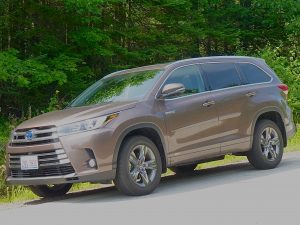
Toyota’s wide range of SUVs includes the high-tech new Highlander Hybrid that combines size with high-20s for fuel economy.
By John Gilbert
Let’s say that you intend to buy an SUV, and you need a large one, and you are a dedicated Toyota loyalist. You have looked at and rejected the Highlander, which is pretty big, and you are intent on going right to the top — the Land Cruiser.
Once you’ve decided to make the investment in the Land Cruiser, you know you are susceptible to one of those lucrative option lists, where you have to fight temptation to greatly increase the already large sticker price. So you ask what’s available. Herein is the biggest surprise of selecting a Land Cruiser.
There are no options.
Your only choice is the exterior color, and the interior color. That means once you’ve accepted the sticker price of $85,520, you can’t add any options. At that price, the Land Cruiser comes equipped, and we mean fully equipped. As in, loaded.
There isn’t even an optional engine available, which means you are forced to “choose” the 5.7-liter dual-overhead-camshaft V8, turning out 381 horsepower and 401 foot-pounds of torque, with full-time 4-wheel drive and a Torsen locking limited-slip center differential, plus its kinetic dynamic suspension, and multi-terrain selection that includes assets such as hill-start assist, off-road turn assist, and even crawl control, which makes the Land Cruiser sound more like some sort of Jeep.
Of course, it does carry the maximum pride of Toyota when it comes to off-road capability, dating back decades to when it was the company’s only off-road vehicle. It was built rugged then, and it continues to be over-engineered for normal family-hauling duty.
For those who might have thought large SUVs had gone the way of dinosaurs, and thought that maybe Chevrolet Suburbans were the only huge SUVs left, think again. The Land Cruiser did get a pretty good makeover a year ago, and the new model carries on, already equipped with a new 8-speed automatic transmission, the full Toyota Safety Series-P active safety equipment, and the ability to tow 8,100 pounds of trailer.
For its great length and roomy 3-row seating, the Land Cruiser drives lighter than seems possible. The suspension makes for a comfortable ride over all surfaces, which includes off-roading and also the challenging state of most urban streets and roadways.
Safety equipment includes lane-departure alert, pre-collision warning, radar cruise control, cross-traffic alert, blind-spot alert, trailer sway control, plus LED headlilghts, daytime running lights, and foglights. And, while not a safety feature, it also has the Entune JBL Audio upgrade. So are those two gigantic 11-inch screens affixed to the backs of the front bucket seats, with wireless headsets for monitoring your own DVDs if you’re a rear-seat occupant. Those back in the third row just have to suffer from long-distance viewing.
Instead of a normal third-row bench, I really like the large rear storage area, with two bucket seats folded up against the outer walls. Trip the latch and they fold down, then from the rear you can reach in, grab the strap on the still-folded seat, and pull on it, and the backrest folds up and into locked position. Reversing it is just as simple, the strap releases the backrest, which you push down and then fold up and in place against the outer wall with ease.
That big V8 in the Land Cruiser has a lot of high-tech equipment, not the least of which is its dual overhead cams, which aids its high-RPM flexibility, and it’s the same powerplant that works in the Tundra full-size pickup.
If you are lured by the high-tech stuff from several other competitors, it will be of considerable interest to comparison shop right there in the Toyota showroom. Toyota is in the process of revising its entire engine line, aiming at stifling the stodgy reputation Toyota has developed in its decades of mechanically sound, trouble-free operation by bringing its 4 and V6 engines up to contemporary high-tech levels.
Such technology is not part of the Land Cruiser’s suite of equipment, which doesn’t mean the Land Cruiser is lacking much, when weighed against its sturdy reputation for wear, although its fuel economy estimates range only from 13 city to 18 highway, and we found we topped out at about 16 miles per gallon in combined driving.
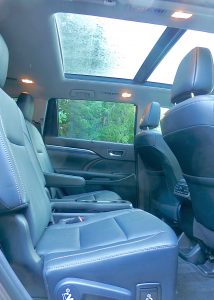
The new Highlander Hybrid benefits from Toyota’s latest technical and creature features, such as the huge sunroof.
By luck, I had just recently been able to spend a week with the 2017 Toyota Highlander, which is more modestly sized, but also has benefitted from Toyota’s modernizing efforts.
For example, the Highlander’s base engine is a large, 2.7-liter 4-cylinder with 185 horsepower and 184 foot-pounds of torque. Its standard upgrade is to an all-new, direct-injected 3.5-liter V6 with 295 horsepower and 268 foot-pounds of torque that should go long distances to eliminate that stodgy reputation.
The test vehicle, meanwhile, was yet another step upward, with the 3.5 V6 connected to an electric-motor system to create a very large Highlander Hybrid. Together, the electric-motor and V6 turn out 300 horsepower, which perks up the tow capacity from 5,000 to 8,500 pounds.
An electronically controlled continuously-variable transmission works smoothly and efficiently to harness that power, with on-demand all-wheel drive. With all of that, the Highlander Hybrid performed with quickness and agility, and rode nicely with double-wishbone rear suspension helping out.
Seating for seven is on perforated leather seats, and unlike the Land Cruiser, you can spend some extra money on options, such as the Platinum package, which includes a panoramic moonroof, heated steering wheel, rain-sensing wipers and dark 19-inch wheels. Sticker price on the Highlander Hybrid was $49,254, which seemed bargain-like when you matched stickers with the $85,000 Land Cruiser.
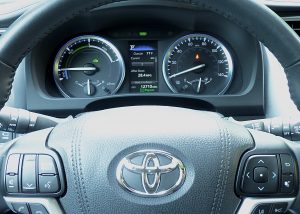
Adjustable information on instrument panel lets you note 28-plus mpg in the large Highlander Hybrid.
With the Hybrid, EPA fuel economy estimates are 29 city and 27 highway, and we were able to get about 28.5 overall, which also looks good compared to the Land Cruiser V8’s thirstiness. A little less size, a little less power, a little more maneuverability, and a lot more technology proves that you can choose which way to go and still never leave the Toyota showroom.


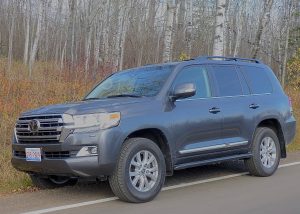

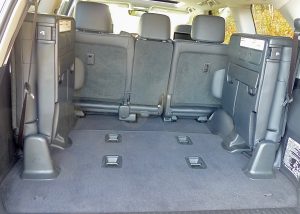
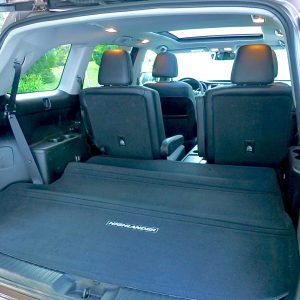
 John Gilbert is a lifetime Minnesotan and career journalist, specializing in cars and sports during and since spending 30 years at the Minneapolis Tribune, now the Star Tribune. More recently, he has continued translating the high-tech world of autos and sharing his passionate insights as a freelance writer/photographer/broadcaster. A member of the prestigious North American Car and Truck of the Year jury since 1993. John can be heard Monday-Friday from 9-11am on 610 KDAL(www.kdal610.com) on the "John Gilbert Show," and writes a column in the Duluth Reader.
John Gilbert is a lifetime Minnesotan and career journalist, specializing in cars and sports during and since spending 30 years at the Minneapolis Tribune, now the Star Tribune. More recently, he has continued translating the high-tech world of autos and sharing his passionate insights as a freelance writer/photographer/broadcaster. A member of the prestigious North American Car and Truck of the Year jury since 1993. John can be heard Monday-Friday from 9-11am on 610 KDAL(www.kdal610.com) on the "John Gilbert Show," and writes a column in the Duluth Reader.